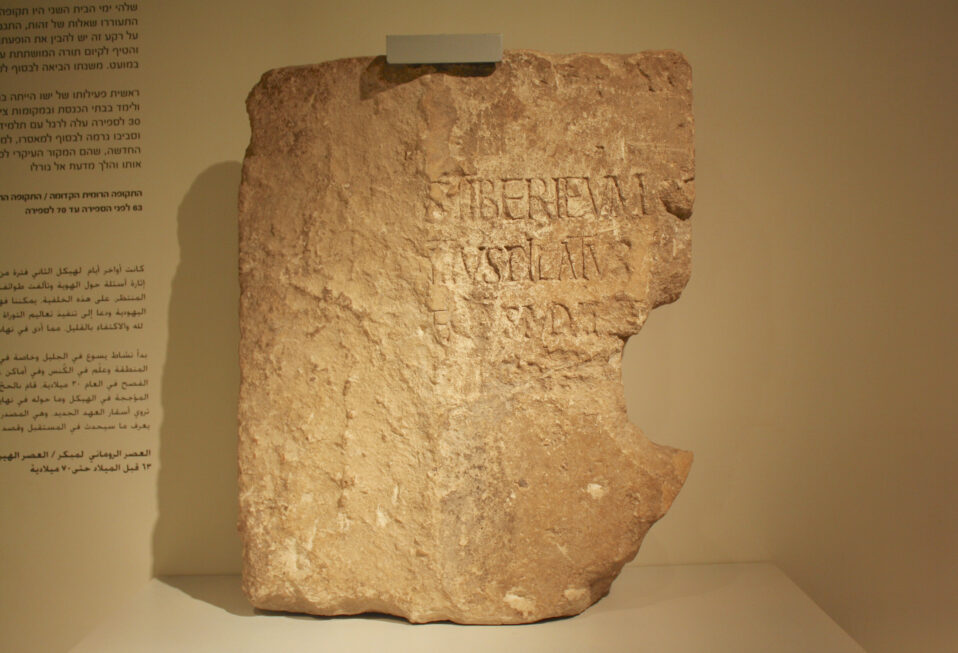There are a number of archaeological findings in Israel related to the New Testament, but there are several discoveries that are particularly worth mentioning here: (1) the Pilate Inscription; (2) the crucified anklebone; (3) the Caiaphas Ossuary; and (4) the Thanatos Inscription.
Pilate Inscription: Archaeological excavations at Herod the Great’s seaside harbor city, Caesarea, uncovered a limestone slab bearing an inscription concerning a Tiberium (a small temple to the Roman Emperor Tiberius) dedicated by Pontius Pilate the Prefect of Judea. Excavators found this stone in secondary use in the theater of Caesarea, but they suggest the Tiberium stood nearby.
This stone is remarkable—not because it bears the name of Pilate, but rather, because it provides a window into Pilate’s psychology. Roman citizens did not build temples to living emperors. Pilate’s Tiberium in Caesarea offers the only example. This speaks to the Prefect’s exaggerated devotion to the emperor, a devotion which surfaces in his condemnation of Jesus.
Crucified Anklebone: Excavations in a northern neighborhood of Jerusalem uncovered a tomb with an ossuary (a box for collecting the bones of the deceased). Inside this box, excavators discovered the anklebone of a man who was crucified. One of the nails remained embedded in the anklebone. The nail hit a knot in the wood causing it to hook, so when they sought to extract it from the man’s ankle, they could not.
This discovery enabled forensic archaeologists to reconstruct the anatomy of crucifixion. A piece of wood was placed on the outside of the ankles to increase the surface area of the nail. Two nails were then driven through both ankles while the crucified victim straddled the upright beam of the cross.
Caiaphas Ossuary: Archaeologists discovered the ossuary—bone box—of the high priest Caiaphas in a southern neighborhood of Jerusalem. Ossuaries were part of secondary burial used in Jewish burial practices from the first century B.C. into the second century A.D. The body of the deceased was laid into a tomb for twelve months for the flesh and organs to decay. After twelve months, friends or family members gathered the bones and placed them in an ossuary.
Many ossuaries have inscriptions bearing the name of the person buried inside. Caiaphas’ ossuary bears the name Yosef, Caipha—Joseph Caiaphas. When excavators discovered the ossuary, they found a skull inside; within the eye sockets, they found two coins, a practice usually attached to pagan burial.
Thanatos Inscription: Josephus, the Jewish historian, describes a small wall separating the outer court of the Temple, where non-Jews were permitted, from the inner, sacred area of the Temple, where only Jews who had been purified could go. Josephus relates that this wall bore signs written in Greek and Latin prohibiting non-Jews from passing beyond this point, under punishment of death (in Greek Thanatos). Two separate copies of this inscription were discovered in Jerusalem.
A complete inscription currently resides in the Archaeological Museum in Istanbul, Turkey. A broken fragmentary version of the inscription is housed in the Israel Museum in Jerusalem. The book of Acts records how Jews accused Paul of bringing non-Jews past this barrier, which caused a riot in the Temple precincts. Paul refers to this in Ephesians calling it the “middle wall of partition.”
Archaeological findings like the ones highlighted above shed light on the world of the Bible. They provide crucial information for us to understand the past. These and other archaeological discoveries add new evidence and information to help us reconstruct the biblical world.
Marc Turnage is President/CEO of Biblical Expeditions. He is an authority on ancient Judaism and Christian origins. He has published widely for both academic and popular audiences. His most recent book, Windows into the Bible, was named by Outreach Magazine as one of its top 100 Christian living resources. Marc is a widely sought-after speaker and a gifted teacher. He has been guiding groups to the lands of the Bible—Israel, Jordan, Egypt, Turkey, Greece, and Italy—for over twenty years.
Website: WITBUniversity.com
Facebook: @witbuniversity
Podcast: Windows into the Bible Podcast




Post a comment